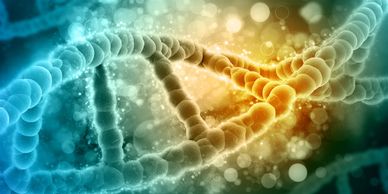NGS
DNA Sequencing Services
Genotyping by Sequencing (GBS)
DNA Sequencing Services

Whole Genome Sequencing (WGS)
- It sequences complete genome of an organism, including nuclear, mitochondrial and chloroplast (in plants) DNA.
- It provides single-base pair resolution for all genome elements.
- It is a powerful tool for both de novo sequencing (species without reference genome) and re-sequencing (species with reference genome).
- It allows the identification of SNPs, CNVs, insertions, deletions, structural changes, coding and non-coding regions.
- It therefore supports all kinds of genome-wide association studies.
Metagenome Sequencing
Genotyping by Sequencing (GBS)
DNA Sequencing Services

- It is a powerful approach for studying microbial communities in their natural environments.
- It allows microbial genomes from environmental samples to be analyzed without prior isolation/cultivation.
- It provides comprehensive information about microbial speciation in test environment such as feces, sputum, gut, contaminated waters, polluted lands etc.
- Metagenome sequencing is thus often used in microbiota studies
Genotyping by Sequencing (GBS)
Genotyping by Sequencing (GBS)

- It is a powerful approach for inter/intra species genotyping, using the potential of restriction enzyme/s and next generation sequencing.
- It considerably reduces genome complexity by restriction enzyme cleavage (single or double digest) but provides high SNP coverage.
- It is a simple, fast, reproducible and lower cost approach for genotyping studies.
- It is therefore widely used in implementations such as GWAS, genetic linkage analysis, plant breeding selection, molecular marker discovery etc.
Targeted Region Sequencing

- Approaches such as targeted or amplicon sequencing and gene panels provide high base-pair resolution because they only target a certain part of the genome.
- As results, they greatly reduce genome complexity and this allows handling large amounts of samples with lower costs.
CRISPR off-target/edit-validation Sequencing
CRISPR off-target/edit-validation Sequencing

- CRISPR is a high-precision genome editing technology but with some disadvantages.
- To eliminate this adversaries, target-edit validation and off-target detection are a must for successful applications.
- In this regard, NGS systems are accepted to be high precise and cost-effective approaches for target-edit validation and off-target detection.
RNA sequencing services
CRISPR off-target/edit-validation Sequencing

Total RNA Sequencing
- It gives a transcriptomic perspective as it provides sequencing for all expressed coding and non-coding RNA types.
- It reveals the global expression levels of each transcript.
- It contributes to the identification of exonic, intronic and intergenic boundaries.
- It allows the identification of novel transcripts and alternate splice variants.
- It allows the detection of allele-specific expressions and transcript fusions.
mRNA Sequencing
- It provides sequencing for all poly-A tailed transcripts that have a functional protein product.
- It saves time and money as it only enriches poly-A tail RNAs, which correspond to the 1-2% of all transcripts.
- Since this is a type of targeted transcriptomic approach, it allows high depth sequencing. This facilitates the identification of low-level expressing transcripts and rare variations.
- It allows the detection of novel transcripts, alternate splice variants, allele-specific expressions and transcript fusions.
Targeted RNA Sequencing
- It targets a specific subset of RNA, and provides higher depth coverage and greater precision.
- With high depth sequencing, it facilitates the identification of low-level expressing transcripts and rare variations.
- This approach is effectively used in understanding of RNA responses to drugs, chemotherapy and other similar applications, as well as in detection/monitoring of cancer and genetic diseases.
small RNA Sequencing
- It provides sequencing for small RNA species such as miRNA, piRNA, siRNA, snoRNA and snRNA, which are smaller than 200 bases and generally expressed at low levels.
- Small RNAs play crucial roles in gene silencing, gene expression regulation, cell development, proliferation, differentiation and apoptosis, thereby their base-level resolution will contribute to the elucidation of many molecular mechanisms and the development of new bio-markers.
- With higher specificity and sequencing coverage rate, small RNA-seq allows the detection of low-expressed RNA species and their sequence heterogeneity.
Long non-coding RNA (lncRNA) Sequencing
- LncRNAs are RNA species (intergenic, intronic, antisense, overlapping, bidirectional) that longer than 200 bases and they form a large portion of non-coding transcriptome.
- They involve in a number of molecular mechanisms such as transcription control, post transcriptional processing, chromatin remodeling, nucleosome repositioning, genomic imprinting and developmental regulation.
- Thereby, their base-level resolution from lncRNA-seq data will contribute to the elucidation of many molecular mechanisms and the development of new bio-markers.
Degradome Sequencing
- It provides sequencing for 5’ uncapped portion (miRNA cleavage site) of mRNA that degraded by miRNAs.
- Sequenced cleavage sites are then aligned to known miRNAs and miRNA targets are identified.
- Considering miRNA role in RNA silencing and post-transcriptional gene expression regulation, it is of great importance to clarify the miRNA-target relationship.
- Degradome sequencing, with its high precision and coverage depth will therefore produce higher base-level resolution for degraded mRNA products.
Commonly utilized services
forms
Files coming soon.
Sugenomik Biotechnology
Address: Ostim Mah, 1308. Cad, No:6 1-14, ODTU Teknokent, Ostim, Ankara
Cookie Policy
We use cookies
We use cookies, tracking and (re-) targeting technologies.
This is so that we can make our webpages more user-friendly and continuously improve them, and show offers and advertisements that are suited to you. If you continue to use our websites, you consent to the use of cookies with the exception of cookies for Google marketing products.
Google marketing products will only be used if you click on "Accept".

